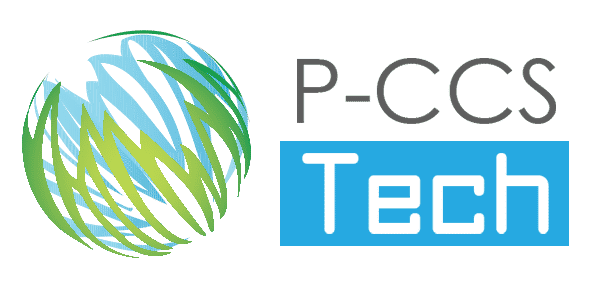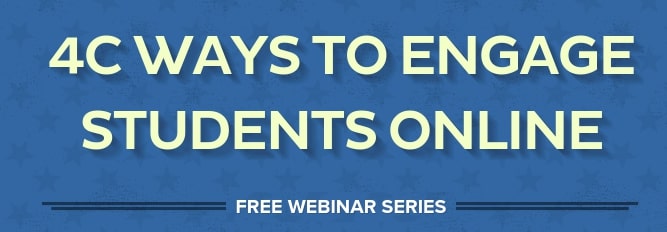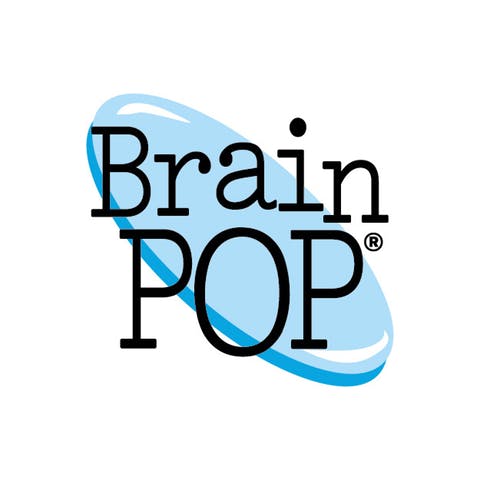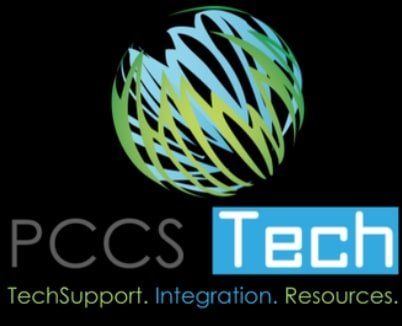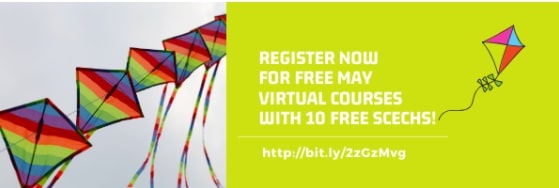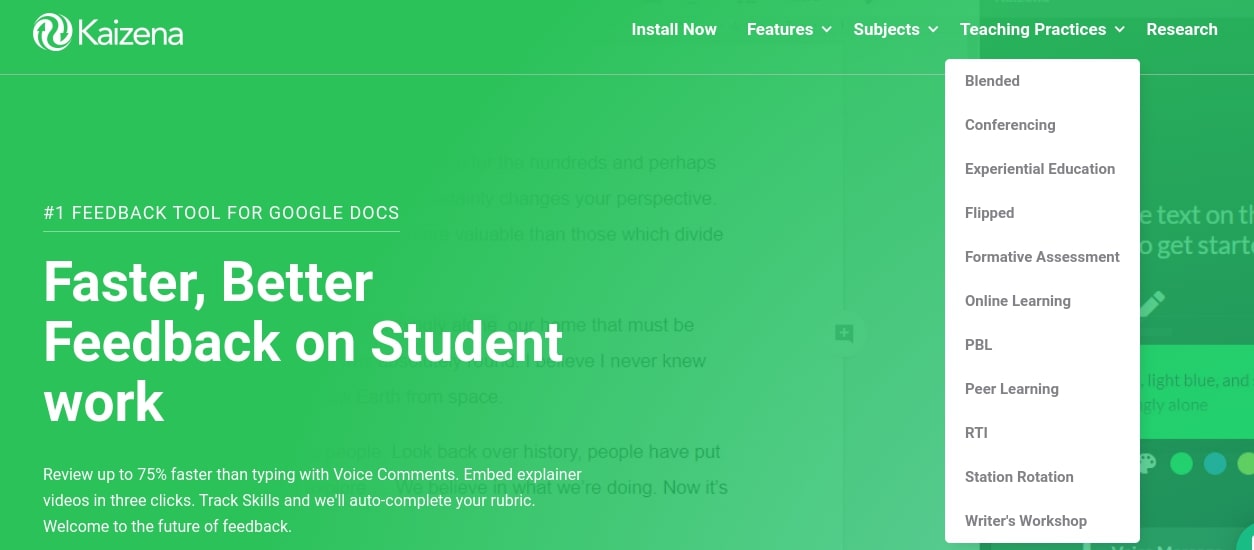For those interested in reviewing the confirmed digital subscriptions for the coming 2020-2021 school year, please check out the dynamically linked spreadsheet below. It will be updated with any new information should changes or new subscriptions be adopted. This sheet will be published via the Home Teaching Hub as well. If you need additional support please connect with a Tech Integration Specialist at tis@pccsk12.com
FREE WEBINAR SERIES on Ways to Engage Students Online
School Is Out For Summer, But We’re Still Here To Help!
Summer is here and we want to remind you that we’re here to support your personal and professional learning over the summer. We know that next year is going to look a bit different with all of the challenges of Covid-19 and re-opening schools and we want to support you in any way we can! There are some opportunities we’re creating to support you as you think about next year and we will be announcing them via The Home Teaching Hub, Tech Blog, and Professional Learning Calendar.
Please note, we have summer 1:1 appointment hours available Monday through Friday. Just navigate to our Calendly link to schedule time with a Tech Integration Specialist. We can help you with specific tech tools or planning for a blended or virtual learning environment or assist you with other tech integration wonders: https://calendly.com/tis-pccs/15min
Consider also adding the professional learning calendar to your Google Calendar so you can get updated directly on your Google Calendar of any newly released learning opportunities. To do so, see guidance below.
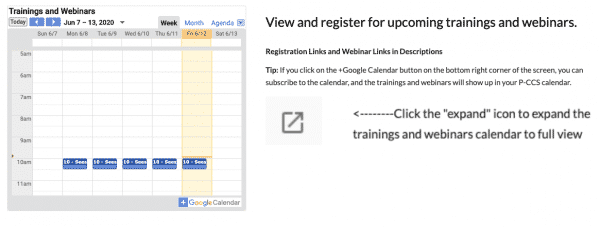
End of Year Google Classroom Cleanup
Google Classroom
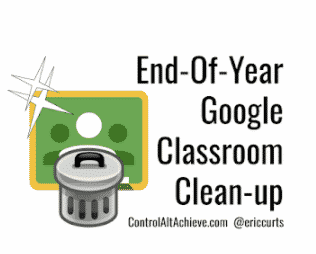 As staff end their year with students, there are several recommendations to consider. You can read more, watch a video, or listen to the podcast from Eric Curts here: controlaltachieve.com/2019/05/classroom-cleanup.html
As staff end their year with students, there are several recommendations to consider. You can read more, watch a video, or listen to the podcast from Eric Curts here: controlaltachieve.com/2019/05/classroom-cleanup.html
Here are the top tips to consider:
Tip #1 – Return all student work
Tip #2 – Unenroll students from old classes
Tip #3 – Archive old classes*
Tip #4 – Remove old class calendars
Tip #5 – Move old class folders in Drive
*Keep in mind that archiving the classes will remove access for students, so if students still need access for some reason, wait until later in the summer to archive. Once the school year has ended, there are some important steps you should take in your Google Classrooms. It’s important to archive finished classes so students don’t see older classes in their dashboards when they login to Google Classroom. Remember, you can use posts/materials from older classes or copy those classes completely for next year.
Archiving a Class
Archiving classes is important so that students do not see old classes in their Google Classroom dashboards when they login. It also declutters your own active Classroom dashboard. Remember, you can always go back and look at archived classes and copy them or use posts/materials/assignments from them. They are not gone forever.
How to Archive a Class
- From the Google Classroom dashboard where you can see all of your classes, click on the 3 vertical dots of the class you’d like to Archive
- Choose Archive from the menu.
- Read the warning and if you’re sure about what you’re doing, click Archive once more.
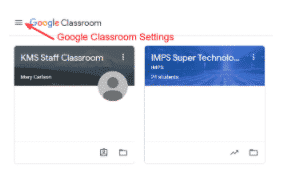 How to View and/or Restore Archived Classes
How to View and/or Restore Archived Classes
- From the Google Classroom dashboard, click on the 3 vertical lines (pancake stack) on the upper left side of screen.
- At the bottom of the slide-out settings menu will be “Archived Classes”. Click on that to see all of your Archived classes. You can look at them and interact with them just like classes that are active.
- You can restore an archived class by clicking the 3 vertical dots of the archived class and choose the Restore option.
Copying a Class
Copying a class creates a copy of the class with all of the materials and assignments in DRAFT status and with no students. It’s highly recommended that you do this from year to year instead of dumping students out of last year’s classroom and adding new students in.
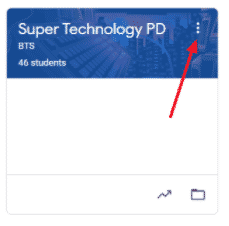 To Copy a Class
To Copy a Class
- From the Google Classroom Dashboard click on the 3 vertical dots in the right corner of the class you want to copy.
- Click on Copy
- Give the new class a name along with a section title. I recommend using the year or semester somewhere in the name or section to make it easier to find later.
- Click Copy when satisfied.
- It will take a minute or two, but then the newly copied class will appear in your Classroom Dashboard. It will be grayed out until it is ready for you to start working in it. Larger classroom will take longer to activate.
Google for Education’s June newsletter highlights
Past Google for Education newsletters have alerted educators to many resources and opportunities. Google’s latest issue #29 (June 2020) is no exception. Pasted below are some of its snippets for your review.
Discover the New Google Teacher Center
Discover free technology training and resources for educators of all levels in the new Teacher Center. We’ve updated the Teacher Center with guide pages for our core products, an updated hub of teacher resources, a communities page to connect you to experts and other educators, and more.
VIA20 Google Certified Innovator Academy
Want to solve a global challenge in education? Applications are now open for the 2020 Google Certified Innovator Academy, which will be delivered online to a Global Cohort. Apply before July 10.
Getting Started with Google for Education
New to Google tools and not sure where to start? Register for our 8-week “Getting Started with Google for Education” email series to receive 10-minute, video-based lessons on the Tuesday of each week. Content is available with subtitles in over 18 languages.
Make Remote Learning Work for Everyone
On May 21st Google celebrated Global Accessibility Day. Learn more about how to make remote learning work for everyone.
Google Play’s Change The Game Design Challenge
For all kids 13-18: Submit to the Design Challenge today! Participants will score an online game dev workshop with other game changers. Clock the entire course to earn a certificate of completion and a new Chromebook!
Remote Reading Support from Rivet
Access remote reading support with one click now that Rivet’s library is available on the web. Includes 3,500+ free, leveled books across 14 kid-friendly categories and word help on every page in addition to recently added books in Spanish.
“Learn Anywhere” with Google Arts & Culture
Created with home learning in mind, 11 Learn Anywhere lesson plans launched on TES. Flexible enough to use in the classroom or for students to work through on their own, they cover a range of subjects, from Dinosaurs to Bauhaus.
Make Remote Learning Fun with Applied Digital Skills
The new Digital Art & Games collection from Applied Digital Skills features 10 at-home lessons to help your students express their creativity and have fun, all while learning digital skills. Students can create a meme with Google Drawings, make a word game in Google Sheets, write an emoji story in Google Docs, and more!
A Guardian’s Guide to CS First
This how-to guide for parents and guardians helps you and your kids get started with CS First, an engaging video-based curriculum that teaches coding through hands-on activities. A great activity to use over summer!
Navigate the Digital World with this Guide
Parents and Guardians can use this Digital Wellbeing Guide to help them spark productive conversations, practice healthy habits, and identify engaging activities with their families.
Please Secure Equipment Before Leaving For Summer Break
Instructional staff, before leaving for your well-deserved summer vacation, please comply with the directions of your principal and main office to turn in or secure all classroom technology equipment such as document cameras, microphones, interactive pens, and remotes. Please leave any Ethernet and USB cables / whips in place, but off the classroom floor. On your last day in your school, would you please also power off all electronics including projectors, interactive flat panels, sound amps, and desktop computers. Please leave printers and copiers plugged in and powered on.
Please also secure or take home all District-assigned devices (laptop, Chromebook, iPad, etc.), as well as all personally-owned devices.
For those that have a classroom cart with student devices (iPads or Chromebooks), please lock your cart after ensuring that all of the devices in your classroom are inside and connected to charge. On a sheet of paper, please print your name, room number and the number of devices contained inside and tape the sheet to the top of your cart. Please make sure that the cart is plugged in to charge and leave it charging in the classroom (unlike past years, please don’t take it to the media center). Please hand the cart key to your building secretary (or in some cases, your principal) and make sure that they have recorded that you turned it in.
District-assigned devices should be brought back when you return to school in the fall OR upon separation of service from the District (retirement, resignation, lay-off, etc.) (please see this document if you are separating from service).
Thanks for your cooperation in helping safeguard district tech!
BrainPOP: High School Access AND an issue with Class Data
Tech Integration Support- Here to Help! *PLEASE READ*
We hope this blog post finds you safe and well.
The Technology Integration Team wants to ensure that EVERY staff member feels supported. Please read on to learn how we are working to support you.
ONLINE HOME TEACHING HUB
We created a GREAT site (but don’t take our word for it) thoughtfully filled with resources to assist you in successfully navigating online teaching and better understanding various tech tools and services. Please consider bookmarking (click star in the address bar) our home teaching hub site: links.pccsk12.com/hth.
USING WEBEX
With Webex being our required platform by May 15th for any student video conferencing, we have created a dedicated Webex and Videoconferencing page filled with how-tos and best practice guidance on the Home Teaching Hub.
CALENDAR OF AVAILABLE TRAINING OPPORTUNITIES
In addition, on both our Webex Help page and the professional learning page, we have a public calendar listing available webinars on how to use Webex Meetings and Webex Events offered both by Cisco Webex staff and by the TIS team. Other training sessions are available through Teq(OTIS), Seesaw, and other vendors. The district-led training offered by Rick and Matt can be identified by the label “P-CCS” at the beginning of the webinar title.
Please note we have 2 Webex training sessions this week.
Wednesday, May 6th- Webex Meeting Training- 12:00-1:00 p.m. – Click to copy to calendar
Thursday, May 7th- Webex Events Training- 12:00-1:00 p.m.- Click to copy to calendar
TO ACCESS and REGISTER for TRAINING and WEBINAR EVENTS:
Click on the specific event shown on the calendar (see sample below from our Professional Learning Page):
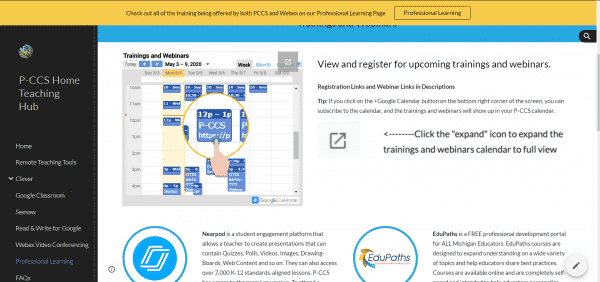
Then click on ‘copy to my calendar’. It’s now on your calendar. Happy learning!
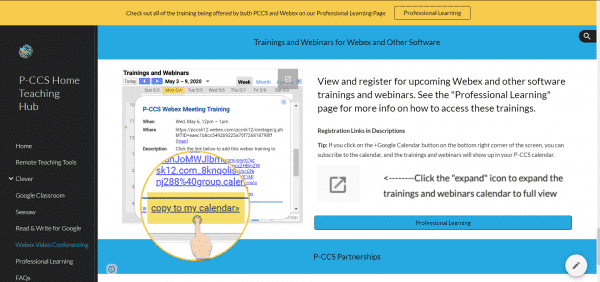
PERSONALIZED APPOINTMENTS
We also understand that some staff would like more individualized support. We’d love to help! Both Matt and Rick have open virtual office hours four hours every day, two hours in the morning and two in the afternoon (9-11 A.M. & 1-3 P.M.) To make a 15 minute (or longer) appointment with us, please click on this link: https://calendly.com/tis-pccs/15min. This link is also located in the signature of our emails.
Please know that we are here to support you however we can.
Thanks!
Your TIS Team,
Matt & Rick
Registration closing soon for free virtual courses offered by REMC in May
For those interested, there’s still time to enroll in a free REMC Virtual Course and earn 10 free SCECHs. To see a description of the courses offered and to register, visit https://mailchi.mp/71fc6deb90f9/theres-still-time-to-sign-up-for-our-free-virtual-learning-courses-3686790?e=67db2526b4
May courses begin on Monday, May 4. The deadline for registration is Friday, May 1. Eleven courses are offered (see list below). Each course is open for three weeks and consists of two (2) one-hour “live” webinars that are recorded and available for viewing later, and eight (8) hours of resource review, assessment developments and written reflection.
- Making the Most of Your Google Classroom
- Ready Set Go 21 Things
- Engaging Students in a Personalized Classroom
- Dynamic Presentations
- Increasing Efficiency and Productivity
- OER to Support Competency-Based Education (CBE)
- Google for Learning: Using SAMR and DOK to Design Authentic Learning Opportunities
- OER: Student-Designed OER for 21st Century Learning
- Google: Applying Google Apps for Education in Chrome, Lvl 1
- Introduction to Personalized & Blended Learning for ALL Students, Level 1
- Social Media: Improve Student Critical Thinking and Collaboration, Level 2
Kaizena feedback-laden Google add-on tool is now installed
Kaizena, another tool (apart from Read&Write for Google) for staff to provide feedback to students within various Google apps, is now installed and available for staff and student use when logged into their Google accounts. Kaziena helps students, teachers, and administrators provide effective and relevant feedback for diverse learners. Its features include: text comments, voice comments, lessons (small micro-units of learning), and skills and rubrics.
Information and videos on getting started and using the add-on can be found at https://help.kaizena.com/en/collections/60518-kaizena-for-google-docs
Easy to associate micro lessons, another feature of the add-on, are described at https://www.kaizena.com/features/lessons
Below are a 2 minute overview video and one that showcases the feedback options:
